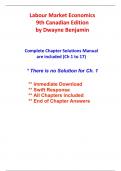Exam (elaborations)
Solutions for Labour Market Economics, 9th Canadian Edition Benjamin (All Chapters included)
Complete Solutions Manual for Labour Market Economics, 9th Canadian Edition by Dwayne Benjamin, Morley Gunderson, Thomas Lemieux, Craig Riddell, Tammy Schirle ; ISBN13: 9781259654848. (Full Chapters included Chapter 1 to 17). *There is no solution for Ch. 1... Chapter 1: Introduction to Labour Mar...
[Show more]



